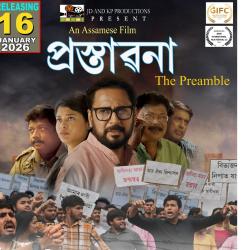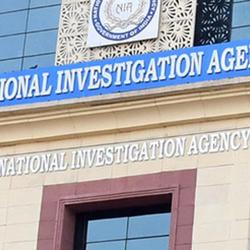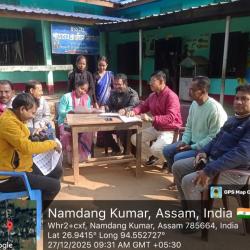Nemati ghat in Jorhat. This is one of the three main riverine routes to reach Majuli, the largest river island in Asia. The other two river fronts being Luit-Khabalu ghat from North Lakhimpur and Dhakuakhana from Dhemaji. This Bohag Bihu, we planned a trip to Majuli and reached Nemati ghat in Jorhat to avail the ferry service of 4:30 p.m. It is the last ferry for the day. The road leading to Nemati ghat was dusty, but the sight of the ghat was disappointing. It was mud, potholes brimming with water and a bumpy, unkempt place all around. This was the doorway to Majuli, the proposed UNESCO world heritage site. Once an island of 1250 sq. km., today Majuli is a shadow of its former self with about 650 sq. km. From 65 Sattras at a point of time, it is only 22 as of now.
 By 5 ‘O’ clock, the ferry was loaded; people in the basement, vehicles on the roof, and people on the roof. It started for Majuli at 5:10 p.m. One hour on the Luit. At dusk we were at the Kamalabari ghat. We got onto a hired taxi which came in the form of a Tata Sumo and embarked on the bumpy ride which never left our side during our stay in Majuli. From Kamalabari ghat, Nemati ghat looked rosier. This is the fate of Majuli. When it comes to roads, there is nothing called good or bad. It is blatantly worse and worst. Is it lack of funds? Simply No. Roads in Majuli is the best example of dearth of will, crisis of commitment and all pervasive corruption.
By 5 ‘O’ clock, the ferry was loaded; people in the basement, vehicles on the roof, and people on the roof. It started for Majuli at 5:10 p.m. One hour on the Luit. At dusk we were at the Kamalabari ghat. We got onto a hired taxi which came in the form of a Tata Sumo and embarked on the bumpy ride which never left our side during our stay in Majuli. From Kamalabari ghat, Nemati ghat looked rosier. This is the fate of Majuli. When it comes to roads, there is nothing called good or bad. It is blatantly worse and worst. Is it lack of funds? Simply No. Roads in Majuli is the best example of dearth of will, crisis of commitment and all pervasive corruption.
On our way to Dakhinpat Sattra, says our guide Prasanta Mili, “Last year this road was better. This time the construction has made it even narrower.” The muddy road didn’t allow him to drive the vehicle straight. The wheels just didn’t obey the steering. They kept skidding in the slippery mud. We had no choice but to walk through the slippery road to reach the monastery. The saving grace was that, unlike Guwahati, the mud was not slush from drains. We were groping through pure mud. My mother was given a strong branch as a stick to help her keep balance. Such was the situation. I wondered what would have happened if her mother (my grandma) too came along…bumpy rides, wading through slippery mud. A trip for the old is forbidden. Roads here will only escalate their back-aches. Nearby boys helped to get the wheels of the Tata Sumo over the mud and relocate the vehicle to a relatively better area on the road. That was far tough than pushing a vehicle through flooded lanes. The youths refused any token or money for ‘saah-paani’ (a term most familiar in government offices of Assam). Here lies the spirit of Majuli…and a Majulian.
 It was at Notun Kamalabari Sattra that we came across a family from Bangalore who came on a vacation to North-East India and was there in Majuli for a day. Most of the tourists in Majuli are from France and South India (we met another family from Shimoga, Karnataka who came to see this form of Vishnu and Krishna worship in Assam). Said Ms. Laxmi, a well-qualified lady and a mother of two from Bangalore, “I was astonished at the horrible condition of roads. How can any government deprive such a large population living in this heritage island of proper roads? Thanks to mobile phones, this area would have been primitive otherwise. Infact, when I saw the dismal condition of Nemati ghat, I thought of stepping back but it was my husband who assured me that everything will be alright.” And we have policy makers talking of promoting Majuli as a site of tourism in the world.
It was at Notun Kamalabari Sattra that we came across a family from Bangalore who came on a vacation to North-East India and was there in Majuli for a day. Most of the tourists in Majuli are from France and South India (we met another family from Shimoga, Karnataka who came to see this form of Vishnu and Krishna worship in Assam). Said Ms. Laxmi, a well-qualified lady and a mother of two from Bangalore, “I was astonished at the horrible condition of roads. How can any government deprive such a large population living in this heritage island of proper roads? Thanks to mobile phones, this area would have been primitive otherwise. Infact, when I saw the dismal condition of Nemati ghat, I thought of stepping back but it was my husband who assured me that everything will be alright.” And we have policy makers talking of promoting Majuli as a site of tourism in the world.
Among the visitors at Auniati Sattra we met Kamal Hazarika, a resident of Kamalabari and a contractor by profession. Our topic of discussion was the dismal roads in Majuli. He let us know that work on construction of roads should be carried out in November. But the Chief Engineer released funds only 20 days before the rainy season. They start work in the first week of April, or a week before Bohag Bihu. This means the work will be washed away by rains and more funds can be siphoned off. Hazarika questions, “People blame us the contractors. But what about the engineers and the bureaucrats? We are only a part of this official red-tapism.” This is the reality. Majuli is not deprived of funds. Majuli is caught in the nexus of bureaucrats-engineers-contractors, not to speak of the people’s representatives who walk the corridors of power. Here the problem is not of fund. Casualty is whole-hearted implementation.
When asked about the communication facility to Majuli, said Lakhi Barua, who deals in mekhala-sador, “We don’t want a bridge from Nemati ghat to Majuli as proposed by some quarters. That would spell doom for the unique culture of our island. Majuli will only be reduced to another Tinisukia. We will witness huge number of people from different communities from other parts of India and Bangladesh usurping our pristine environ. We just want that the three ghats of Nemati, Luit-Khabalu and Dhakuakhana be renovated and uplifted with modern facilities. The ferry services should be improved. This will help retain the heritage of Majuli and attract tourists, as well as limit the flow of migrant settlers.”
No doubt Majuli has all potential to become a centre of Religious Tourism as is Vatican city or Mecca. But with such dismal river-ports and horrible roads in the island, where does Majuli stand? As aptly said by Mohini Mohan Deka, a visitor from Nagaon whom we met on the ferry way back to Nemati ghat, “Majuli is not a world heritage site. It has been reduced to a site of fund exploitation where the concerned slice off their share of the pie.”
Khorali (autumn and winter) is the best time to work on the roads of Majuli. But the construction work is deliberately postponed to and near barixa (rainy season). New soil, stones, raw-materials are dumped onto the roads only to be washed away as soon as possible. Then there will be brand new fund, fresh tenders, newer ‘percent’s to be shared. The cycle goes on…
(Some names have been changed with due respect to the reluctance of the speakers)
- Add new comment
- 46279 reads










Comments
Pages
Add new comment